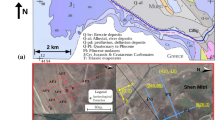Abstract
This paper proposes a two-stage geophysical approach to map the vertical cracking and the structural integrity of flood embankments made up of clay geomaterials susceptible to fissuring. The first stage is based on a ‘coarse-resolution’ investigation using conventional electrical resistivity tomography (ERT) equipment to identify the fissured zones in the embankment. This step is complemented by an additional geophysical technique, electromagnetic, to verify the ERT measurements. The second stage is based on a ‘high-resolution’ investigation using a miniature ERT system previously developed at the laboratory scale for detailed mapping of the fissure patterns. The ‘coarse-resolution’ stage is the major focus of this paper and was validated against two case studies in England and Scotland. Longitudinal ERT survey provided a tomographic picture of the upper desiccated zones of the embankments and fissured areas in 2-D, validating the range of resistivity results obtained previously on a fissured clay model in the laboratory. A transversal embankment resistivity tomography was also completed to show the positions of fissured zones in detail in the field. The electromagnetic technique as a fast screening tool allowed cross checking the ERT results and was also efficient in detecting high and low conductivity zones, indicating areas of potential weakness during flash floods and heavy rain. The southern embankment in England showed more fluctuations in the conductivity and resistivity than the north embankment in Scotland, likely to be due to the differences in climate, vegetation and location characteristics between the two sites. Conclusions were also drawn on the potential weaknesses for both embankments and the effect of vegetation on conductivity measurements.









Similar content being viewed by others

References
McDowell PW et al (2002) Geophysics in engineering investigations. Construction industry research and information association CIRIA C562
Cooling LF, Marsland A (1954). Soil Mechanics Studies in the sea defense banks of Essex and Kent. In: Proceedings of the ICE conference on the North Sea floods of 31st January/1 February 1953
Dyer MR, Utili S, Zielinski M (2009) Field study into fine desiccation fissuring at Thorngumbald. In: ICE Proceedings on water management (WM3), pp 221–232
Griffiths DH, Barker RD (1993) Two-dimensional resistivity imaging and modelling in areas of complex geology. J Appl Geophys 29:211–226
Hemingway KL, Cutts NC, Pérez-Dominguez R (2008) Managed Realignment in the Humber estuary, UK. Institute of Estuarine and Coastal Studies (IECS), University of Hull, UK. Report produced as part of the European Interreg IIIB HARBASINS project
Jones G, Zielinski M, Sentenac P (2012) Mapping of desiccation fissures in flood embankments using 3D electrical resistivity tomography. J Appl Geophys 84:39–51
Lataste JF, Sirieix C, Breysse D, Frappa M (2003) Electrical resistivity measurement applied to cracking assessment on reinforced concrete structures in civil engineering. NDT&E Int 36(6):383–394
Marsland A (1968) The shrinkage and fissuring of clay in flood banks. Building research establishment internal report No 39/68
Nguyen F et al (2005) Image processing of 2D resistivity data for imaging faults. J Appl Geophys 57(4):260–277
Reynolds JM (1997) An introduction to applied and environmental geophysics. Wiley, Chichester
Samouëlian A et al (2003) Electrical resistivity imaging for detecting soil cracking at the centimetric scale. Soil Sci Soc Am J 67(5):1319–1326
Sentenac P, Zielinski M (2009) Clay fine fissuring monitoring using miniature geo-electrical resistivity arrays. J Environ Geol 59:205–214
Slater L (2007) Near surface electrical characterization of hydraulic conductivity from petrophysical properties to aquifer geometries, a review. Surv Geophys 28:169–197
Tabbagh J, Samouëlian A, Cousin I (2007) Numerical modelling of direct current electrical resistivity for the characterisation of cracks in soils. J Appl Geophys 62(4):313–323
Zielinski M, Sentenac P, McCloskey G, Dyer M (2010) Desiccation cracking detection using resistivity array. In: ICE Proceedings on geotechnical engineering, GE-D-10-00068
Acknowledgments
The authors would like to express their sincere thanks to EPSRC, AXA and the KTA from Strathclyde University for their support towards the funding for this research. Special thanks to the Scottish Executive, the Institution of Civil Engineers, the East Ayrshire Council (Galston), the Environment Agency (Hull) for their continuous support and help and Mr. Ron Baron for his technical advice on pictures quality.
Author information
Authors and Affiliations
Corresponding author
Electronic supplementary material
Below is the link to the electronic supplementary material.
12665_2012_2026_MOESM1_ESM.jpg
Supplementary Fig. 1 Typical Wenner - Schlumberger resistivity arrays for 4 and 48 electrodes configuration (JPEG 117 kb)
Supplementary Fig. 4 Calibration of the electromagnetic CMD on known locations from maps (TIF 61 kb)
12665_2012_2026_MOESM6_ESM.tif
Supplementary Fig. 6 Miniature “High rsolution” ERT with vertical cracking pattern. 48 electrodes with half spacing grid (TIF 1,466 kb)
Rights and permissions
About this article
Cite this article
Sentenac, P., Jones, G., Zielinski, M. et al. An approach for the geophysical assessment of fissuring of estuary and river flood embankments: validation against two case studies in England and Scotland. Environ Earth Sci 69, 1939–1949 (2013). https://doi.org/10.1007/s12665-012-2026-z
Received:
Accepted:
Published:
Issue Date:
DOI: https://doi.org/10.1007/s12665-012-2026-z



